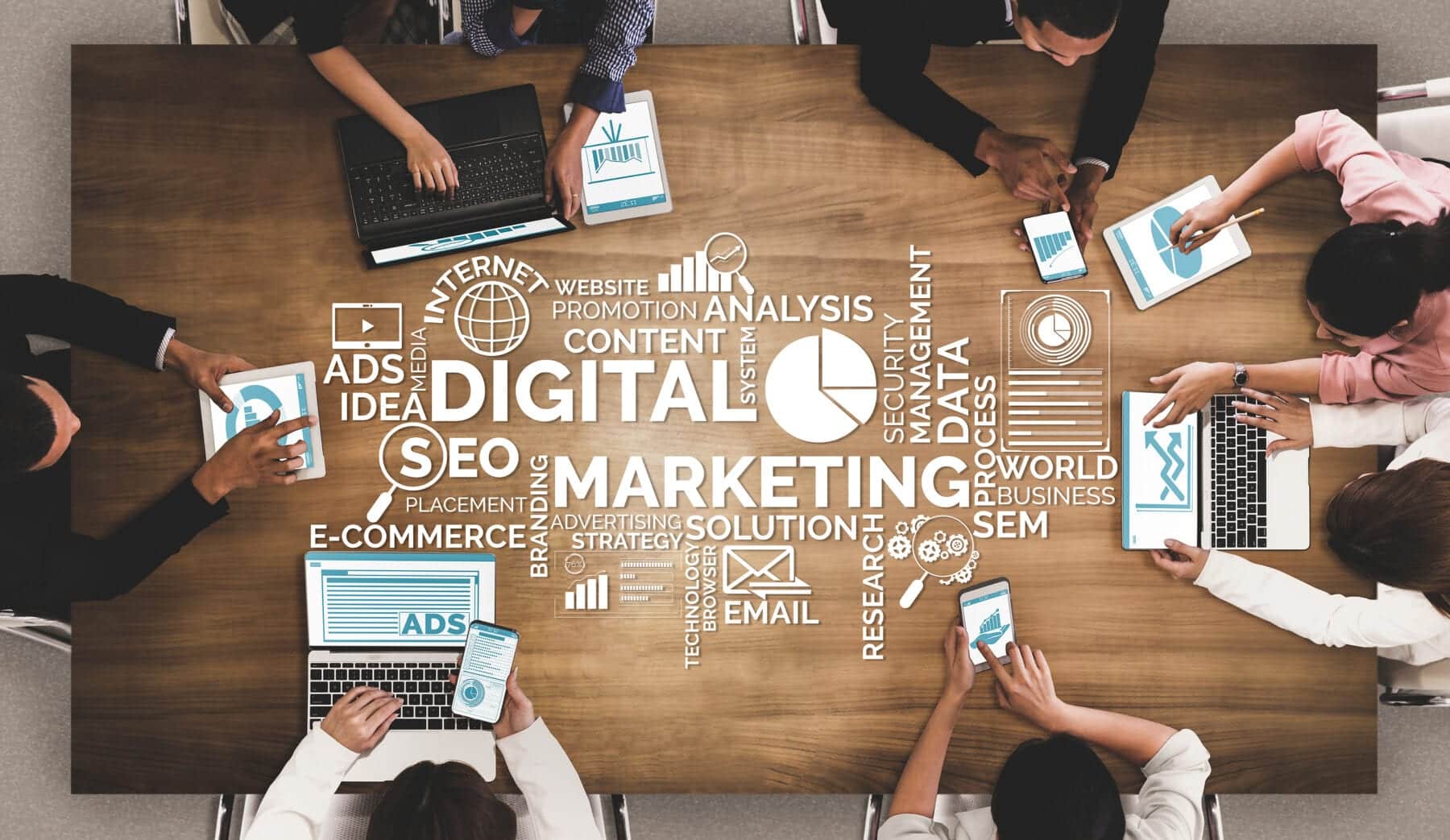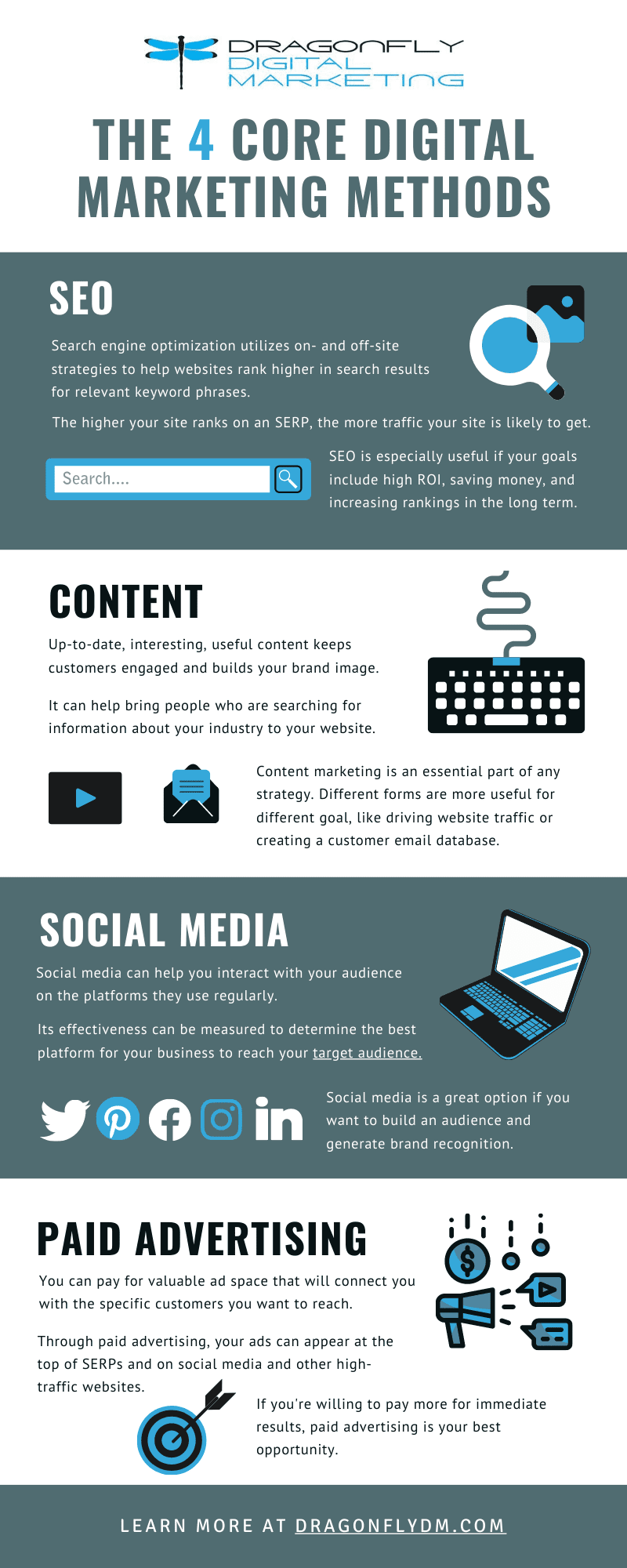Digital marketing is comprised of four core elements: SEO, content, social media, and paid advertising. While the comprehensive digital marketing strategy includes all four, some work better than others depending on specific goals. If you’re looking to choose a specific method or two to focus on, you’ll need to consider a variety of factors, such as budget and how quickly you need to see results. Read on for our tips on determining which of the four core methods will be most lucrative for your business.
SEO – Long-term ROI
Search engine optimization (SEO) relates to any strategy that helps you gain organic rankings on search engines.
Google, the most popular search engine with a 92.5% global market share, uses quality raters to determine whether they want to promote a website based on things like expertise, authority, and trustworthiness (EAT). Appearing within the first couple of pages of a Google search is important. After all, 93% of online experiences begin with a search engine, and the first five organic results in an SERP account for 67.6% of clicks.
SEO can help you reach a wide range of customers and is a critical part of a digital marketing strategy, particularly if you are more focused on long-term goals rather than fast results. It takes some time to build an optimized SEO foundation and drive traffic, but SEO has a high return on investment (ROI). SEO often takes about 3-6 months to gain traction, but once your site is optimized, growth can be exponential.
Content Marketing – A Major Part of Any Strategy
Content marketing is a great way to attract people to your website. Some examples of content marketing include:
- Blog posts
- Scholarly articles
- Email lists
- Newsletters
- eBooks
- Videos
- Images/infographics
Content marketing is a highly effective strategy for businesses that want to establish authority in their industry. While businesses in all industries can benefit from content marketing, certain types are more effective than others, depending on what they want to achieve. For example, if you’re a contractor, you might use content as a major part of your digital marketing strategy if you want to earn more website traffic. You can add a blog to your website and generate posts with new information in that field. When potential clients search for that information, they will reach your blog, which will then connect them with your services.
Outbound
Outbound content marketing is intended to sell products and generally exists as a one-way conversation – you speaking to your audience. If you want to prioritize sending your marketing information directly to customers, rather than building and maintaining social media pages and other areas that are a bit more time consuming, outbound marketing, such as sending coupons and newsletters via email, might be a good option. This is especially useful for businesses that want to bring customers into their brick-and-mortar locations rather than to their websites to sell products.
You can use email, for example, as a form of outbound marketing in order to engage regularly with customers and establish familiarity with your brand in a fast, automated way. Your email content should reflect your brand image in everything from the templates, fonts, and colors you use to the either more colloquial or professional tone in which you write. This will give existing and potential customers a good idea of who you are as a company and make you more recognizable and familiar to them without having to invest a lot of time.
Inbound
Inbound content marketing, on the other hand, is meant to bring potential customers to you through interactive, useful content. Examples of inbound marketing include websites, blogs, and eBooks. If your goal is bringing more traffic to your website in order to sell products, inbound marketing is a useful tool.
Generating content that is backed by credible sources, provides solutions and useful information, and encourages engagement will create an audience for your brand. It will also drive traffic to your website, where you are selling your products and services. This type of content marketing will target your most ideal audience and ultimately convert them into customers.
Social Media – Brand Building through Relationships
Another form of inbound marketing, social media is a lucrative platform for many businesses. Worldwide, there are an estimated 3.6 billion people using social media, which is expected to increase to 4.41 billion by 2025. Social media platforms that offer ad space include:
If your priority is building your brand and establishing a customer base, social media might be the best channel to focus your efforts. Maintaining active social media accounts for your business creates a space for you to communicate with your customers, which builds brand loyalty, encourages interest, and drives traffic to your website. Social media makes it easy to communicate quickly with a wide audience and show your customers that you are interested in engaging with them, ultimately building a positive brand image.
If you are looking for some insights about your target audience, social media is a measurable digital marketing tool. These analytics allow businesses to target their audiences more specifically than ever before and see what’s working and what isn’t. For example, 35% of Instagram users are between the ages of 25 and 34. If that’s an age group you want to pursue, focusing on Instagram marketing might be especially lucrative for you. Social media is a great way to make sure that you’re getting your money’s worth, since analytics will reflect which social media platforms are working the best to accomplish your goals.
Paid Advertising – More Spend, Fast Results
Online paid advertising is the purchasing of ad space with the goal of attracting website traffic. Most people see paid ads during their regular online activities daily, from Instagram images to Facebook videos to sponsored results on Google. Many social media platforms offer advertising services through which you can pay for your ads to be sent strategically to specific user groups. For example, Facebook allows businesses to target their audiences based on the following criteria:
- Core audience – Based on age, interests, and geography
- Custom audience – Focused on reconnecting with people who have previously engaged with your business
- Lookalike audience – Reaches out to new people whose interests are similar to those of your existing customers
There are obvious benefits to paid advertising, primarily speed and efficiency. Ads placed strategically on social media or search engines with the intention of targeting your customer demographic can result in a rapid uptick in website traffic. In fact, 41% of all clicks go to the top three paid ads on an SERP. Services that offer paid ad space will promote your content to users that are most likely to be converted into customers, making it a smart investment with a high ROI. If you are looking to invest a little more money for faster results, focusing on this method might be a good choice for you.
In Conclusion
While digital marketing encompasses a range of strategies, SEO, content, social media, and paid advertising are the core. Marketing on the internet is a faster, measurable, more efficient way to keep current customers and reach new ones using applications and websites they already visit regularly. While all four methods of digital marketing are useful, some work better than others, depending on a variety of factors, like specific goals and target markets. Consider what you most want to achieve, how much you want to spend, and how fast you need to see results when deciding digital marketing efforts in which to invest.


